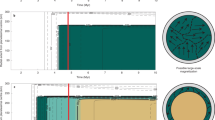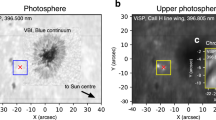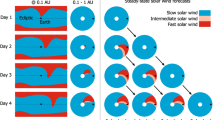Abstract
METEORITES which fall to Earth's surface generally carry permanent magnetisation which probably was acquired early in their history1. In particular, carbonaceous chondrites, which are generally assumed to be virtually unaltered relicts from the earliest Solar System processes of condensation and accretion2, have apparently been magnetised in magnetic fields with intensities in the range 0.1–10 G (refs 1, 3, 4). The origin of the magnetising field has remained obscure; explanations proposed to account for the field, include a strong central solar field in the early Sun, an intense solar wind magnetic field, magnetic fields generated in large parent objects—ancestral to the meteorites—and the interstellar magnetic field transiently compressed during the Solar System's formation. So far as we know, none of these mechanisms has been shown quantitatively capable of accounting for measured meteoritic remanence5. We suggest here that the magnetic field recorded in the remanence of carbonaceous chondrites may have been produced by a self-excited hydro-magnetic dynamo in the gaseous preplanetary nebula from which the Solar System is thought to have formed.
This is a preview of subscription content, access via your institution
Access options
Subscribe to this journal
Receive 51 print issues and online access
$199.00 per year
only $3.90 per issue
Buy this article
- Purchase on SpringerLink
- Instant access to full article PDF
Prices may be subject to local taxes which are calculated during checkout
Similar content being viewed by others
References
Brecher, A. in Comets, Asteroids, Meteorites (ed. Delsemme, A. H.) 415 (University of Toledo Press, 1977).
Wasson, J. T. Meteorites (Springer, Berlin, 1974).
Butler, R. F. Earth planet. Sci. Lett. 17, 120 (1972).
Lanoix, M., Strangway, D. W. & Pearce, G. W. Lunar planet. Sci. IX, Abstr. (NASA Washington, D. C. 1978).
Levy, E. H. & Sonett, C. P. in Protostars and Planets (ed. Gehrels, T.) (University of Arizona Press, in the press).
Safronov, V. S. Evolution of the Protoplanetary Cloud, (NASA translation, TTF 667, Washington, D. C. 1972).
Schatzman, E. Physics of the Solar System, 413 (NASA TMX 65702 1971).
Cameron, A. G. W. & Pine, M. R. Icarus 18, 377 (1973).
Cameron, A. G. W. Proc. NATO Advanced Study Institute on the Origin of the Solar System (in the press).
Cameron, A. G. W. Center for Astrophysics Preprint No. 841 (1977).
Lee, T., Papanastassiou, D. A. & Wasserburg, G. J. Geophys. Res. Lett. 3, 109 (1976).
Cameron, A. G. W. & Truran, J. W. Icarus 30, 447 (1977).
Parker, E. N. Astrophys. J. 162, 665 (1970).
Levy, E. H. A. Rev. Earth planet. Sci. 4, 159 (1976).
Consolmagno, G. J. & Jokipii, J. R. Moon and Planets (in the press).
Parker, E. N. Astrophys. J. 163, 255 (1971).
Spitzer, L., Jr, Diffuse Matter in Space (Wiley New York, 1968).
Author information
Authors and Affiliations
Rights and permissions
About this article
Cite this article
LEVY, E. Magnetic field in the primitive solar nebula. Nature 276, 481 (1978). https://doi.org/10.1038/276481a0
Received:
Accepted:
Issue date:
DOI: https://doi.org/10.1038/276481a0



